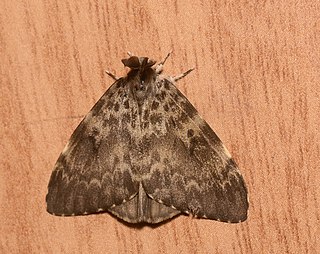
Olene mendosa, the brown tussock moth or hairy tussock moth, is a moth of the family Erebidae. The species was first described by Jacob Hübner in 1823. It is found in India, Bangladesh, Sri Lanka, Indonesia, Taiwan, Thailand and Australia.

Lymantria is a genus of tussock moths in the family Erebidae. They are widely distributed throughout Europe, Japan, India, Sri Lanka, Myanmar, Java, and Celebes. The genus was erected by Jacob Hübner in 1819.

Lymantria mathura, the rosy gypsy moth, is a species of moth of the family Erebidae found in the Russian Far East, Nepal, Japan, the Korean Peninsula, northern India and China. The species was first described by Frederic Moore in 1866.
Teleclita strigata is a moth of the family Notodontidae first described by Frederic Moore in 1879.
Antheraea cingalesa, the Sri Lankan tussar silk moth, is a moth of the family Saturniidae. The species was first described by Frederic Moore in 1883. It is endemic to Sri Lanka.
Arctornis subvitrea is a moth of the family Erebidae first described by Francis Walker in 1865. It is found in India and Sri Lanka.
Artaxa guttata is a moth of the family Erebidae first described by Francis Walker in 1855. It is found in Bangladesh, Sri Lanka, and India.
Bembina apicalis is a moth of the family Erebidae first described by Francis Walker in 1865. It is found in India and Sri Lanka.
Cispia alba is a moth of the family Erebidae first described by Frederic Moore in 1879. It is found in Sri Lanka.
Euproctis fraterna is a moth of the family Erebidae first described by Frederic Moore in 1883. It is found in the Maldives, India, Sri Lanka and the Seychelles.

Euproctis lunata, the castor hairy caterpillar, is a moth of the family Erebidae. The species was first described by Francis Walker in 1855. It is found in India, Pakistan, Sri Lanka and Thailand.
Euproctis rhoda is a moth of the family Erebidae first described by Frederic Moore in 1879. It is sometimes classified as a subspecies of Euproctis howra. It is found in India, Sri Lanka, Myanmar, the Andaman Islands and Australia.

Lymantria ampla is a moth of the family Erebidae first described by Francis Walker in 1855. It is found in India and Sri Lanka.
Lymantria fuliginosa is a moth of the family Erebidae first described by Frederic Moore in 1883. It is found in Sri Lanka and India.

Lymantria grandis is a moth of the family Erebidae first described by Francis Walker in 1855. It is found in Sri Lanka.

Lymantria incerta is a moth of the family Erebidae first described by Francis Walker in 1855. It is found in India and Sri Lanka.

Lymantria marginata is a moth of the family Erebidae first described by Francis Walker in 1855. It is found in India, Bangladesh, Sri Lanka and Thailand.
Lymantria subrosea is a moth of the family Erebidae first described by Francis Walker in 1855. It is found from Sri Lanka to China and Sundaland, the Philippines, Sulawesi, Seram, the Lesser Sundas to Timor. The Sumatran population is categorized under the subspecies, Lymantria subrosea singapura.
Cusuma vilis is a moth of the family Geometridae first described by Francis Walker in 1854. It is found in Sri Lanka.
Dysphania prunicolor is a moth of the family Geometridae first described by Frederic Moore in 1879. It is found in India and may be found in Sri Lanka.









